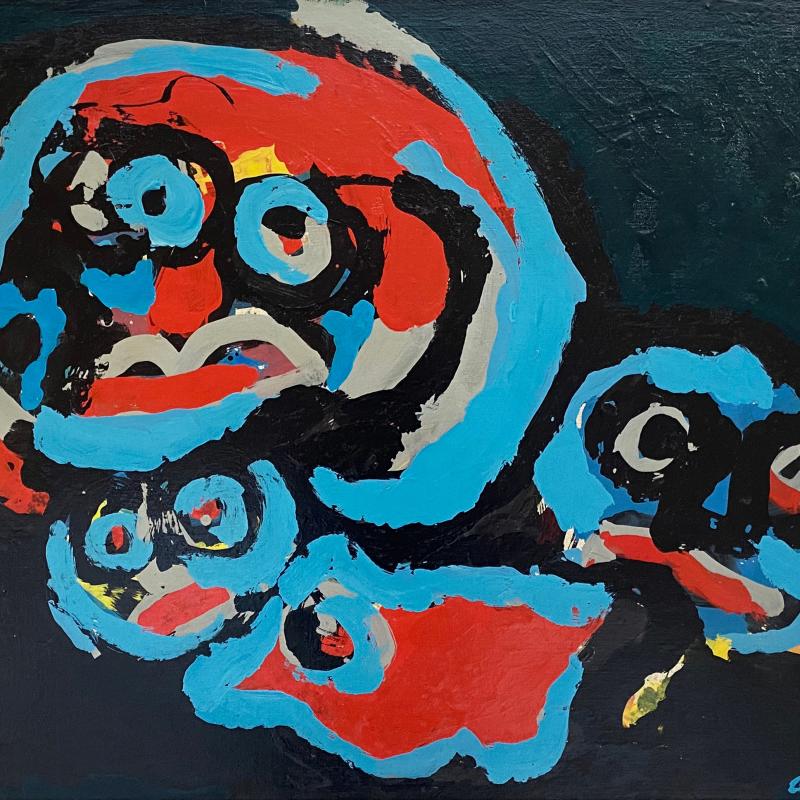-
 Karel AppelFigures, 1975Oil on paper mounted to canvas31 x 41 3/4 inches,
Karel AppelFigures, 1975Oil on paper mounted to canvas31 x 41 3/4 inches,
Framed: 40 1/2 x 51 1/2 inchesSigned: Appel 75 lower right
-
 Karel AppelFigure CompositionAcrylic on canvas25 3/4 x 32 1/4 inches,
Karel AppelFigure CompositionAcrylic on canvas25 3/4 x 32 1/4 inches,
Framed: 35 1/4 x 41 1/2 inchesSigned: Appel lower right
Marked: Til Jette Lanbberg / fra mar og far. (verso on stretcher)
Overview
Christiaan Karel Appel was born on April 25, 1921 in his parents' house at Dapperstraat 7 in Amsterdam, The Netherlands. Appel's father ran his barber shop business out of the first floor of this very same house. His mother Johanna Chevalier was a descendant of wealthy French Huguenots. When he turned fourteen, Appel produced his first painting which was a fruit basket still life. On the occasion of his fifteenth birthday Appel's wealthy uncle Karel Chevalier presented him with an easel and paint set as well as some painting lessons. During the Second World War from 1940 until 1943 Appel enrolled at the Rijksakademie van Beeldende Kunsten. In 1946 he held his first show in Groningen, the largest city in Northern Netherlands.
Appel's art at this time was heavily influenced by the works of Pablo Picasso, Henri Matisse and Jean Dubuffet. Appel first aligned himself with the Nederlandse Experimentele Groep. Then he helped to establish the CoBrA (Copenhagen, Brussels, and Amsterdam) Group in 1948 along with fellow artists Corneille, Constant, Asger Jorn, Pierre Alchinsky, and Jan Nieuwenhuys in reaction to the "action painters" of the New York School of Abstract Painting. Their aim was to elevate instinct in the creation of art and to oppose all intellectual approaches to art. At this time Appel also began to make artworks from junk - assemblages he called poubelles ("dustbins"). In 1949 Appel created a controversial fresco of children for the Amsterdam City Hall. Depending on how the title "Vragende Kinderen" was translated, the title could either be translated as "questioning children" or "begging children". The result was that the work caused a huge uproar. The artist had sought to create a new openness, but the Dutch civil servants could only see violence of which they had experienced too much in the recently ended past war. As a result the mural was quickly whitewashed over, a state in which it remained for the following twenty years. Appel was furious at what he saw as rejection and censorship and decamped to France where he lived in a ruined castle in Auxerre.
After about 1950 Appel began to concentrate on creating sculpture. He designed large scale wooden reliefs of which his "Appel Circus" works (1976-1978) are the most memorable. He later replaced the wood medium for colored polyester and then later aluminum. In the early 1980s, Appel and the poet Allen Ginsburg collaborated on a series of visual poems. The two men bonded over a mutual love of jazz. In the early 1990s, Appel began to paint opera sets and Tuscan landscapes. He was awarded the 27th International Biennale's UNESCO Prize in Venice in 1954 and the First Prize at the Guggenheim International Exhibition in New York in 1960. Appel died on May 3, 2006 at his home in Zurich, Switzerland from a heart ailment and was buried in Père Lachaise Cemetery in Paris, France. In addition to his large body of paintings, Appel will also be remembered for his prints, sculptures, graphics and illustrations, ceramics, as well as his large murals and large room decorations. Appel is often considered the leading figure in the modern generation of Dutch artists. He stands as the most important Dutch artist of the 20th century.
Awards
UNESCO Prize, Venice Biennale, 1954
Graphics Prize, Ljubljana Biennal, Yugoslavia
International Painting Prize, Sao Paulo Bienal
John Solomon Guggenheim Fellowship Award, New York
Â
Exhibitions
 Palais des Beaux Arts, Bruxelles
Stedelijk Museum, "Young Artists" Exhibition, Amsterdam, 1949
Sao Paulo Biennale, 1953 (Honorable Mention), 1959 (First Prize for Painting)
Venice Biennale, 1954 (UNESCO Prize)
Kassel's Documenta III
Museum of Modern Art
World's Fair, Dutch Pavilion, 1957
Guggenheim Museum, New York, 1960 (Guggenheim International Award, 1960)
Museums and Public Collections
The Albertina, Vienna
Arizona State University Art Museum, Tempe
Art Institute of Chicago
Bilbao Fine Arts Museum, Spain
Brauer Museum of Art at Valparaiso University, Indiana
Canton Museum of Art, Ohio
Chazen Museum of Art at the University of Wisconsin
Dallas Museum of Art, Texas
Didrichsen Art Museum, Helsinki, Finland
Dordrechts Museum, Netherlands
Fine Arts Museums of San Francisco
GAM - Galleria Civica d'Arte Moderna e Contemporanea, Turin
Guilford College Art Gallery, North Carolina
Guggenheim Museum, New York City
Haifa Museum, Haifa, Israel
Harvard University Art Museums, Massachusetts
Haugesund Museum of Fine Art, Norway
Hirshhorn Museum and Sculpture Garden, Washington D.C.
Hofstra University Museum, Hempstead, New York
Hunterian Museum and Art Gallery, University of Glasgow, Scotland
Indianapolis Museum of Art,Â
Ludwig Museum of Contemporary Art, Budapest
MacKenzie Art Gallery, Saskatchewan
Mildred Lane Kemper Art Museum, St. Louis, Missouri
Museu de Arte de São Paulo, BrazilÂ
Museum Boijmans Van Beuningen, Rotterdam
Museum of Fine Arts, Boston
Museum of Modern Art, New York City
National Galleries of Scotland, Edinburgh
Peggy Guggenheim Collection, Venice
Oklahoma City Museum of Art, Oklahoma
Pomona College Museum of Art, California
Rijksmuseum Twenthe, Enschede, NetherlandsÂ
Royal Museums of Fine Arts of Belgium Catalogue (in French)  Â
S.M.A.K. (Stedelijk Museum voor Actuele Kunst), Ghent, Belgium
Stedelijk Museum of Modern Art, Amsterdam
Tate Gallery, London, UK
Thyssen-Bornemisza Museum, Madrid
Ulster Museum, Belfast, Northern IrelandÂ
UNESCO Building, Paris Â
Van Abbemuseum, Netherlands
Walker Art Center, Minnesota
Washington University Gallery of Art, Missouri
Wichita Art Museum, Kansas